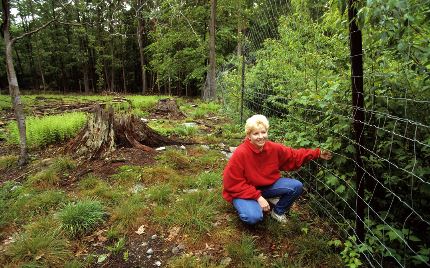Low-Cost Fence Designs to Limit Deer Impacts in Woodlands and Sugarbushes

The white-tailed deer (Odocoileus virginianus) can significantly influence the diversity, longevity, and sustainability of rural woodlands, forests, and maple syrup sugarbushes. As selective browsers, deer will eat some plants more readily than they will eat other plants. Many of the tree species deer prefer to consume are valued by owners as sources of timber, maple syrup, or as food-producing trees for wildlife, such as oak and maple.
Long-term impacts of deer browsing on woodlands and sugarbushes can persist for decades after deer impacts are reduced (called “legacy” effects). In areas with a history of deer overabundance, the failure to establish and grow new, young trees is having a detrimental effect on woodlands and their ability to remain healthy and diverse.
When deer impact is high, plants used to assess problems eat the plants. When deer impact decreases, the evidence of deer impact decreases. The appearance of heavily browsed woods may seem more picturesque and open than degraded and impoverished to an untrained eye. The following features indicate an overabundance of deer in woodlands:
- The woods have a park-like appearance
- Invasive shrubs dominate the understory
- Ferns dominate the understory
- Woody brush dominates the understory
- Lower canopy browse line
- Tree seedlings that have been cropped or “Bonsai”
- Lack of or stunted wildflowers such as Trillium, Indian cucumber, or Jack-in-the-pulpit.
In most cases, recreational hunting is insufficient to control the impact that deer have on native vegetation. Depending on landscape pattern, deer population size, and food availability, approximately 40% to 60% of a deer herd must die or be culled each year to stabilize the population. Reducing the population requires even greater mortality. As the hunter demographic becomes older and less effective, and land is less accessible for hunting, the management impact of recreational hunting is increasingly limited. In some cases, recreational hunting may be able to help augment other deer management strategies and reduce the impacts of deer.
Protection of isolated trees is possible with wire cages or tree tubes. Several tree tube designs are available. Tree tubes should be at least 5 ft tall and with ventilation ports to allow air circulation. Tree tubes need to be securely staked to the ground and checked annually to ensure the tube is functional and the bottom in full contact with the soil. Tree cages made from 2″ x 4″ welded wire or poultry wire should be 5 ft tall and well staked. Some nut trees and conifers may do better in larger diameter cages than in tubes. Weed management around the tube or cage is necessary to improve seedling growth, and will limit habitat for rodents that might girdle the seedling.
For larger areas, fencing is an option that is more efficient and cost-effective than tubes or cages. Fencing typically includes clearing an access trail, driving posts where needed, and the use of large machinery to transport 8 ft woven wire fence spools. Some newer designs use 8 ft plastic mesh fence that allows for the use of small and less expensive fence posts. No fence perfectly excludes deer, and all deer fences require inspection and some amount of maintenance. The most expensive fences, but most effective deer fences, are made of woven wire with driven fence posts. Installation costs are typically $2.50 to almost $4 or more per running foot.
Researchers at Cornell University and Cornell University Department of Natural Resources are assessing the costs and efficacy of two fencing designs to prevent or limit deer impacts. The objective is to identify low-cost options that adequately exclude deer until tree seedlings grow above their reach. The two fencing methods use either plastic mesh or high tensile wire as the fencing material, and these designs are being tested in 0.5 to 2 acre areas that have been managed through thinning or harvesting to increase sunlight and accelerate the establishment and growth of woodland regeneration. In some cases, herbicides were used to control interfering understory plants.
The designs are affordable for private woodland owners, and continued research is evaluating the long-term effectiveness of the designs at excluding deer. Fences will need to be maintained until seedlings of desired species are at least 5 feet tall. In the early years, vegetation inside the fence may look similar to vegetation outside the fence; however, in later years, deer may recognize that the vegetation is actually “greener on the other side of the fence” and be more likely to challenge the fence.
After one growing season, seedlings inside the enclosures were significantly taller than seedlings outside the enclosure. If fences remain effective, a significantly higher percentage of seedlings may grow beyond the susceptible browsing height in a shortened time frame. An appropriate number and height of seedlings is necessary to consider a woodland opening having sufficient stocking, or seedling density depending on seedling height at the time of fencing, past deer pressure, soil quality, and amount of sunlight. This fact sheet will be updated as new data become available on the effectiveness of these fence designs.
Rather than attaching fencing directly to the tree, a bat-ten strip made from pressure-treated wood is attached to the tree with a nail and fender washer. At most one or two nails per tree are used. On fence corners, the trees should be 7″ – 8″ DBH (diameter at breast height), but trees as small as 3″ DBH will suffice on straight runs of the fence. As the tree grows, it pushes against the batten strip which pushes against the fender washer, which floats the nail. The design prevents the typical situation where the tree grows around the fence material. If after 5-10 years the seedlings may be at a safe height and the fence can be removed, then you may remove the batten strip and nails.
Table of Contents
Installation of plastic mesh fencing
Identify the perimeter of your property and flag low-value trees to serve as living fence posts. Select trees to be on the “inside” of the fence (avoid spans of more than 60 feet). Avoid abrupt fence corners. The best results come from selecting trees before harvesting, and protecting those trees from damage or removal during harvest.
To simplify access, clear significant brush from the fence line. Repositioning the fence may be cheaper than clearing brush.
Install one plastic insulator for each 10″ batten strip using deck screws or joist hanger nails. Predrill holes for fender washers and nails to prevent board splitting. Attach batten strips to trees so that the insulator is approximately 54 to 58 inches above the ground.
In order to tighten 12 gauge wire through insulators, a wire tensioner and splicing clips are used.
After unrolling, position the fence so that it hangs from the wire.
Using hog rings every 18 to 24 inches, attach the plastic mesh fence to the wire.
Gates are created by cutting the fence vertically and attaching an apron that extends approximately 4 feet on either side of the opening
By piling brush or slash under fences, deer won’t be able to crawl under fences left by ground topography. The fence will be more effective if it is lined with brush or slash continuously along the outside edge, eliminating the need for baling twine.
Use baling twine around saplings, around wooden stakes, or fiberglass rods offset from the fence approximately 30″ off the ground.
It is recommended to inspect the fence every two to three years, as well as after storms.
The total project cost averages $0.59 per running foot, with labor estimated at $15/hour and materials at $0.59/running foot.
Adding another strand of wire approximately 12 inches off the ground would likely be more effective in restricting deer movement, while also costing less. Labor costs would be as much as double due to the extra effort to install another wire and handle a 7 ft fence VS. a 5 ft spoon, and using a ladder to hog-ring the fence to the top wire.
Fencing made of high tensile steel
In spite of the lower materials costs, high-tensile fencing requires twice as much labor due to the use of high-tensile galvanized wire of standard 12 gauge.
Fencing materials with high tensile strength
- Farm stores charge different prices for 12 gauge galvanized wire
- For 4,000 feet of wire, it costs $100, or $0.03 per foot
- An 8 foot long pressure-treated deck board with a thickness of 1 14 inches and a width of 5 12 inches,
- Pressure-treated 2x4s (approximately $3.67 per board)
- Plastic electric fence insulators
- Deck screws or galvanized joist hanger nails
- Nails with a diameter of three to 3.5 inches that are rust-proof (e.g., galvanized)
- 25″ to 1.5″ fender washers
Installation of high-tensile fencing
- Flag low-value trees along your perimeter to serve as living fence posts. There should be at least one tree every 40-50 feet (avoid spans over 60 feet). If possible, place the trees on the fence’s “inside.” Avoid abrupt fence corners. Selecting trees before harvesting requires protecting them from damage or removal during harvesting. Choosing trees before harvesting results in the best results.
- To simplify access, remove significant brush from the fence line. Repositioning the fence may be less expensive than clearing the brush.
- Attach plastic insulators to batten strips using deck screws or joist hanger nails at approximately 10″, 20″, 30″, 40″, 54″, 68″, 82″, and 96″.
- The top wire should be threaded through the uppermost insulator of each board before nailing it to the tree.
- The board can be secured with a nail and fender washer near the ground line and a nail and washer anywhere along the batten.
- A wire tensioner and splicing clips are used to tighten the wires through the insulators. Thread the wire one at a time to avoid intertwining. Tightening the wire helps secure the board to the tree.
- A continuous windrow of brush or slash on the outside edge of the fence will enhance its effectiveness and eliminate the need for baling twine if the ground topography leaves gaps under your fence.
- The diameter and firmness of trees at angled points in the fence should be sufficient to withstand significant side strain.
- Baling twine can be wrapped around saplings, around wooden stakes, or around fiberglass rods with clips. The twine should be installed approximately 30″ from the fence and 30″ above the ground.
It is recommended to inspect the fence two to three times a year after storms.
With labor estimated at $15/hour and materials estimated at $10/yard, the average project cost $0.51/running foot.




